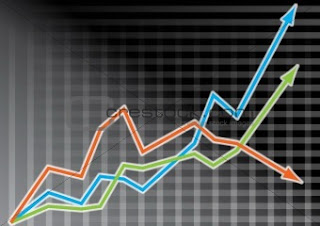The fundas
CRR - The portion of depositors' balances banks must have on hand as cash. [currently 6 percent]
Repo Rate - Rate at which RBI lends to banks [currently 6.75%]
Reverse Repo Rate - The Rate at which RBI borrows money from bank [currently 5.75%]
Inflation - The rate at which the general level of prices for goods and services is rising, and, subsequently, purchasing power is falling.[currently 9.3 %]
** The RBI inclreased Repo and Reverse Repo Rate by 25 basis points.
RBI Strategy & Its Effects
The RBI in order to reduce Inflation , RBI has
1. Increased CRR
2. Increased Repo Rate
3. Increased Reverse Repo Rate
Effects
Increasing all these rates, the RBI sucks out liquidity in the system.
The increase in the policy rates directly impacts the Indian Banks, as the margin for lending is compressed as their funds become scarer.This makes the banks to increase lending rates.
This affects people who are about to get [bank/car/personal] loans, it also affects people who are involved in Small or Medium level business as they are starved for funds.
The next affected are Real estate developers, as they are already howling with the latest Budget.
Coming to the Common man, higher policy rates leaves less money in the markets as the borrowings are less as well this will bring down the GDP of the country automatically.This decreases number of jobs.
*** If there are so many spill over effects, how come the strategic decision of RBI can reduce inflation.
Time Being Solution
The RBI has to be patient till problems wit Gulf countries settle out, so that the Oil prices is back to normal.
The RBI has to be on the look out for monsoon to be punctual every year.
Waiting for your comments..,,
CRR - The portion of depositors' balances banks must have on hand as cash. [currently 6 percent]
Repo Rate - Rate at which RBI lends to banks [currently 6.75%]
Reverse Repo Rate - The Rate at which RBI borrows money from bank [currently 5.75%]
Inflation - The rate at which the general level of prices for goods and services is rising, and, subsequently, purchasing power is falling.[currently 9.3 %]
** The RBI inclreased Repo and Reverse Repo Rate by 25 basis points.
RBI Strategy & Its Effects
The RBI in order to reduce Inflation , RBI has
1. Increased CRR
2. Increased Repo Rate
3. Increased Reverse Repo Rate
Effects
Increasing all these rates, the RBI sucks out liquidity in the system.
The increase in the policy rates directly impacts the Indian Banks, as the margin for lending is compressed as their funds become scarer.This makes the banks to increase lending rates.
This affects people who are about to get [bank/car/personal] loans, it also affects people who are involved in Small or Medium level business as they are starved for funds.
The next affected are Real estate developers, as they are already howling with the latest Budget.
Coming to the Common man, higher policy rates leaves less money in the markets as the borrowings are less as well this will bring down the GDP of the country automatically.This decreases number of jobs.
*** If there are so many spill over effects, how come the strategic decision of RBI can reduce inflation.
Time Being Solution
The RBI has to be patient till problems wit Gulf countries settle out, so that the Oil prices is back to normal.
The RBI has to be on the look out for monsoon to be punctual every year.
Waiting for your comments..,,


